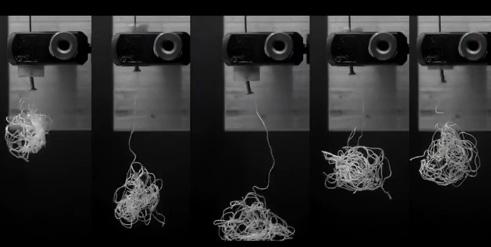
Researchers find optimal frequency at which fiber is extracted the fastest.
Inspired by an observation of a leech preying on a ball of California blackworm, postdoctoral researcher Ishant Tiwari and his collaborators in Assistant Professor Saad Bhamla’s lab at Georgia Tech’s School of Chemical and Biomolecular Engineering conducted an experiment that could help solve a major issue of our age: how best to extract a specific cable from that tangle of defunct and obsolete wires you keep in your desk drawer. In particular, the team sought to optimize a strategy that many people might adopt instinctively: grabbing the desired cable and giving it a good shake.
Their video of this experiment was a winner of the “Gallery of Soft Matter” competition at the American Physical Society (APS) March Meeting in Minneapolis. Minnesota.
Despite the ubiquity of test materials in offices worldwide, Tiwari and colleagues experimented on tangles of cotton threads, which they created by tumbling the threads and a few small weights in a box. They then moved on to pieces of loosely woven gauze, which gave a more reproducible measure of entanglement. They fixed the target thread—with the tangle or gauze dangling below—to a piston, which oscillated vertically at a variable rate.
The researchers found that the fastest way to extract the thread was to maximize the periods during which the thread was being jerked upwards and the tangle’s center of mass was moving downwards due to gravity. This is achieved when the oscillation rate is just right. Too slow, and the thread is not tensioned enough on the upstroke, and the thread and tangle rise as one. Too fast, and the thread’s upward motion doesn’t have time to spread to the whole tangle before its direction is changed, meaning the tangle’s center of mass hardly moves during the cycle.
“We are currently building a scaled-up version of our untangler to extract actual wires from a tangle!” Tiwari said. But the work could also have broader applications. “Thinking about how the dynamics of a tangle were different for different frequencies of motion can potentially help us design new topological metamaterials with tunable frequency responses,” he said.
Writer: Marric Stephens, APS

Ishant Tiwari